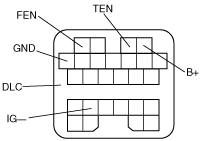 |
ENGINE TUNE-UP [F2]
id011094800600
Engine Tune-up Preparation
Using the M-MDS
1. Warm up the engine to normal operating temperature.
2. Shift the transmission into neutral.
3. Turn off all electrical loads.
4. Verify that the steering wheel is at straight ahead position.
5. Connect the M-MDS to the DLC-2.
Not using the M-MDS
1. Warm up the engine to normal operating temperature.
2. Shift the transmission into neutral.
3. Turn off all electrical loads.
4. Verify that the steering wheel is at straight ahead position.
5. Connect a dwell tachometer to the DLC terminal IG-.
arnffw00001098
|
Ignition Timing Adjustment
Using the M-MDS
1. Perform “ENGINE TUNE-UP PREPARATION”. (See Engine Tune-up Preparation.)
2. Use a jumper wire to short terminal TEN of the DLC to body ground.
arnffw00001093
|
3. Verify that the RPM PID is within the specification.
4. Connect the timing light to the high-tension lead of the No.1 cylinder.
5. Verify that the timing mark on the crankshaft pulley is within the specification.
6. Tighten the distributor lock bolts to the specified torque.
7. Disconnect a jumper wire.
8. Verify that the timing mark on the crankshaft pulley is within the specification.
Not using the M-MDS
1. Perform “ENGINE TUNE-UP PREPARATION”. (See Engine Tune-up Preparation.)
2. Use a jumper wire to short terminal TEN of the DLC to body ground.
arnffw00001093
|
3. Verify that the idle speed is within the specification.
4. Connect the timing light to the high-tension lead of the No.1 cylinder.
5. Verify that the timing mark on the crankshaft pulley is within the specification.
6. Tighten the distributor lock bolts to the specified torque.
7. Disconnect a jumper wire.
8. Verify that the timing mark on the crankshaft pulley is within the specification.
Idle Speed Adjustment
Using the M-MDS
1. Perform “ENGINE TUNE-UP PREPARATION”. (See Engine Tune-up Preparation.)
2. Use a jumper wire to short terminal TEN of the DLC to body ground.
arnffw00001093
|
3. Verify that the RPM PID is within the specification.
4. Disconnect a jumper wire.
Not using the M-MDS
1. Perform “ENGINE TUNE-UP PREPARATION”. (See Engine Tune-up Preparation.)
2. Use a jumper wire to short terminal TEN of the DLC to body ground.
arnffw00001093
|
3. Verify that the idle speed is within the specification using the dwell tachometer.
4. Disconnect a jumper wire.
5. Disconnect the dwell tachometer.
Idle-up Speed Inspection
Using the M-MDS
1. Perform “ENGINE TUNE-UP PREPARATION” (See Engine Tune-up Preparation.)
2. Verify that the idle speed is normal. (See Idle Speed Adjustment.)
3. Verify that the RPM PID is within the specification.
Idle speed
|
Load condition |
Idle-up speed (rpm)*1 |
|---|---|
|
P/S ON*2
|
700—800
|
|
A/C ON*3
|
780—880
|
Not using the M-MDS
1. Perform “ENGNE TUNE-UP PREPARATION”. (See Engine Tune-up Preparation.)
2. Verify that the idle speed is normal. (See Idle Speed Adjustment.)
3. Verify that the idle-up speed is within the specification.
Idle speed
|
Load condition |
Idle-up speed (rpm)*1 |
|---|---|
|
P/S ON*2
|
700—800
|
|
A/C ON*3
|
780—880
|
Idle Mixture Inspection
1. Perform “ENGNE TUNE-UP PREPARATION”. (See Idle Speed Adjustment.)
2. Verify that the idle speed and ignition timing are within the specification. (See Idle Speed Adjustment.) (See Ignition Timing Adjustment.)
3. Turn the test mode off.
4. Warm up the engine by holding the engine speed at 2,500—3,000 rpm for approx. 3 min.
5. Insert an exhaust gas analyzer to the tailpipe.
6. Verify that the CO and HC concentrations are within the regulation.